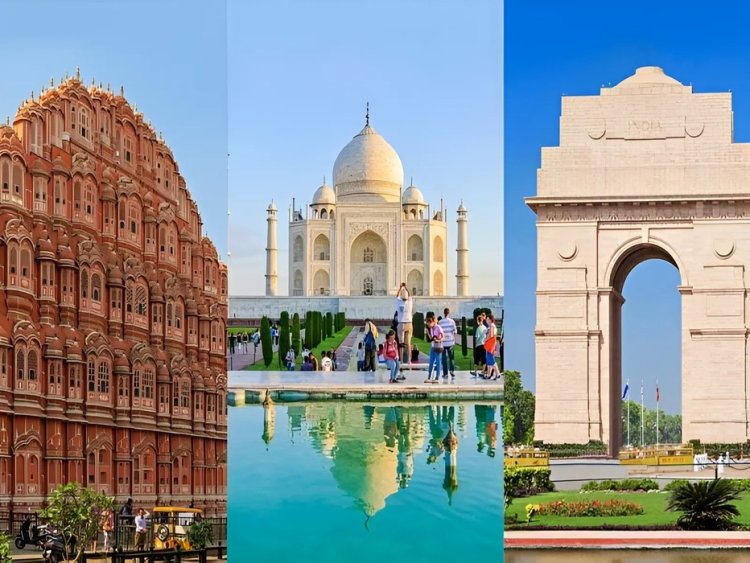Top 5 unforgettable reasons to visit golden triangle
Share this Post to earn Money ( Upto ₹100 per 1000 Views )

The Golden Triangle, encompassing Delhi, Agra, and Jaipur, is one of India’s most renowned and captivating travel circuits. This iconic route offers an unparalleled glimpse into the country’s rich cultural heritage, historical grandeur, and architectural brilliance. Each city within this triangle holds its own unique charm and significance, creating a perfect blend of experiences that showcase India’s diverse legacy.

Delhi, the bustling capital, offers a fascinating mix of ancient monuments and modern marvels. From the majestic Red Fort and Humayun's Tomb to the vibrant streets of Chandni Chowk, Delhi provides a deep dive into India’s historical and contemporary culture. Agra, home to the world-famous Taj Mahal, is synonymous with romantic splendor and Mughal architectural excellence. This UNESCO World Heritage Site, along with the Agra Fort, captivates visitors with its timeless beauty. Jaipur, known as the Pink City, enchants with its regal palaces, forts, and vibrant markets, offering a window into Rajasthan's royal past.
Together, these cities form a captivating itinerary that not only highlights India’s architectural masterpieces but also provides a rich cultural experience, making the Golden Triangle a must-visit destination for anyone exploring India.
Here are some unforgettable reasons to visit the Golden Triangle:
1. Heritage and Architecture:

Golden Triangle India, the home of the oldest civilization on Earth, is well-known for its elaborate architecture and rich history. India is a country full of forts, palaces, mosques, temples, monuments, and historic ruins. It is also incredibly beautiful and has a diverse architectural style. Indian systems have changed as a result of numerous dynasties and European colonial control. With thirty-two locations around the country designated as UNESCO World Heritage Sites, India is a popular travel destination for those who enjoy history and design.
2. Spirituality and religion:
Numerous religions, including Buddhism, Sikhism, Jainism, Hinduism, and diverse religious ideologies, have their roots in India. In India, spirituality and religion are deeply entwined with daily existence. The majority of visitors come to India looking for serenity and a quiet setting conducive to introspection. Exploring the various religious scriptures and visiting India's temples can offer a more profound understanding of Indian culture.
The Lotus Temple, Jama Majid, Gurudwara Bangla Sahib, Laxmi Narayan Mandir in Delhi, and Birla Mandir in Jaipur are among the places where devoted faith followers can be seen performing their rituals.
3. Culture:

India has a plethora of complex fairs, cultural and religious festivals, and holiday events on its calendar. India celebrates the colourful festivals of Holi and Diwali widely, particularly in the Golden Triangle. Jaipur, also known as the Pink City, is home to several vibrant festivals, such as the Teej Fair and the Gangaur Kite Festival, which fill the city with people flying kites, painted elephants, ornamented camels, tattooed women, and turbans with red tops.
4. Purchasing:
To fully feel the alluring vivacity of the Golden Triangle, head to an Indian bazaar, where shoppers and merchants navigate bargaining sales and a flurry of activity in pursuit of specific food items and other consumer products. Another alternative for tourists is to go shopping in a more organized fashion at the Old Delhi Bazaar Walk or other bazaars in Agra and Jaipur.
5. Indian Cuisine:

Indian cuisine is a delectable culinary adventure, thanks to its inventive taste and presentation pairings, use of exotic spices, and fresh Flavors. Influenced by Persian and Mughlai culinary techniques, the cuisine of northern India features dishes like butter chicken, chapathi (flatbread), chana masala (chickpea curry), and chaat (deep-fried potato patties).
Delhi is home to a plethora of excellent local and international dining options, which can be found at establishments such as Hauz Khas, Chandni Chowk (a haven for chaat enthusiasts), and Paranthe Wali Gali (which serves delicious paranthas and sweet delicacies like jalebi, chaat papdi, golgappas, samosas, and chai). Don't pass up the opportunity to eat at Indian Accent in Delhi, one of the best restaurants in the world and the only eatery in India to make this esteemed list. Take care of yourself!
India's cuisine, culture, and customs have been molded over time by the country's lengthy history, distinct topography, and numerous conquerors, explorers, and neighbours. Indian cuisine is a significant aspect of the country's culture and is traditionally consumed on both official holidays and in daily life.
Conclusion
The Golden Triangle Tour encapsulates the essence of India’s rich heritage and diverse culture in a way that is both captivating and memorable. Each city within this iconic triangle Delhi, Agra, and Jaipur offers unique experiences that collectively highlight India’s historical grandeur and architectural splendor. The awe-inspiring Taj Mahal in Agra stands as a testament to eternal love, while Delhi’s historical sites, such as the Red Fort and Qutub Minar, provide a deep dive into India’s past and present. Jaipur’s regal palaces and vibrant markets offer a glimpse into the opulence of Rajasthan’s royal history.
The Golden Triangle Tour is not just a journey through India’s most famous landmarks but also an immersion into its vibrant culture and culinary delights. From exploring the bustling streets of Delhi to marvelling at the intricate details of the Taj Mahal and experiencing the majestic forts of Jaipur, this tour offers a well-rounded adventure. By visiting these three remarkable cities, travelers gain a comprehensive understanding of India’s diverse heritage, making the Golden Triangle Tour an unforgettable experience that perfectly encapsulates the spirit of this fascinating country.
















